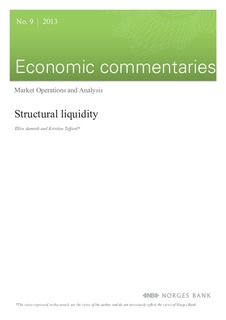| dc.contributor.author | Aamodt, Ellen | |
| dc.contributor.author | Tafjord, Kristian | |
| dc.date.accessioned | 2018-08-15T12:03:52Z | |
| dc.date.available | 2018-08-15T12:03:52Z | |
| dc.date.issued | 2013 | |
| dc.identifier.uri | http://hdl.handle.net/11250/2558148 | |
| dc.description.abstract | Structural liquidity refers to the level of reserves in the banking system prior to market operations by Norges Bank to supply or drain reserves from the banking system. Only the central bank can create reserves. However, transactions undertaken by the government, which has an account at Norges Bank, can influence structural liquidity. Daily variations in structural liquidity are primarily determined by transactions of this kind between the government and its counterparties with accounts at private banks. This commentary discusses the factors that influence structural liquidity, what determines the level and why currently, structural liquidity is occasionally positive. We conclude with a comment on the structural liquidity forecast for 2014. | nb_NO |
| dc.language.iso | eng | nb_NO |
| dc.publisher | Norges Bank | nb_NO |
| dc.relation.ispartofseries | Economic Commentaries;9/2013 | |
| dc.rights | Attribution-NonCommercial-NoDerivatives 4.0 Internasjonal | * |
| dc.rights | Attribution-NonCommercial-NoDerivatives 4.0 Internasjonal | * |
| dc.rights.uri | http://creativecommons.org/licenses/by-nc-nd/4.0/deed.no | * |
| dc.title | Structural Liquidity | nb_NO |
| dc.type | Others | nb_NO |
| dc.description.version | publishedVersion | nb_NO |
| dc.subject.nsi | VDP::Samfunnsvitenskap: 200::Økonomi: 210::Samfunnsøkonomi: 212 | nb_NO |
| dc.source.pagenumber | 14 | nb_NO |

